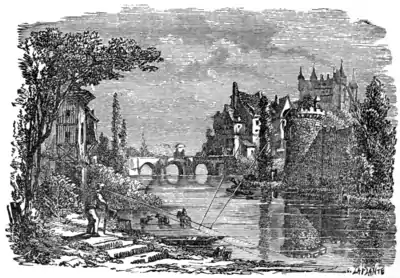110
THE WONDERS OF OPTICS
There are two kinds of mirrors—plane and curved. We will first examine the properties of the former sort, being those which are ordinarily applied to the usages of every-day life.
In the figure in the preceding page we have a young lady looking at her reflection in a tall cheval glass. Every point upon the surface of her clothes and face is reflected back to her eye from the surface of the tin amalgam which has been applied to the back of the mirror by the looking-glass maker, for the purpose of rendering the image of the object more brilliant than if the glass alone were used. The rays which proceed from every one of these points strike upon the surface of this metallic layer, are stopped by its opacity, and are reflected

Fig. 17.—Reflection from the Surface of Water.
back to the eye at an angle equal to that at which they strike the surface. The image seen by the eye is formed, consequently, by the reflection of every one of